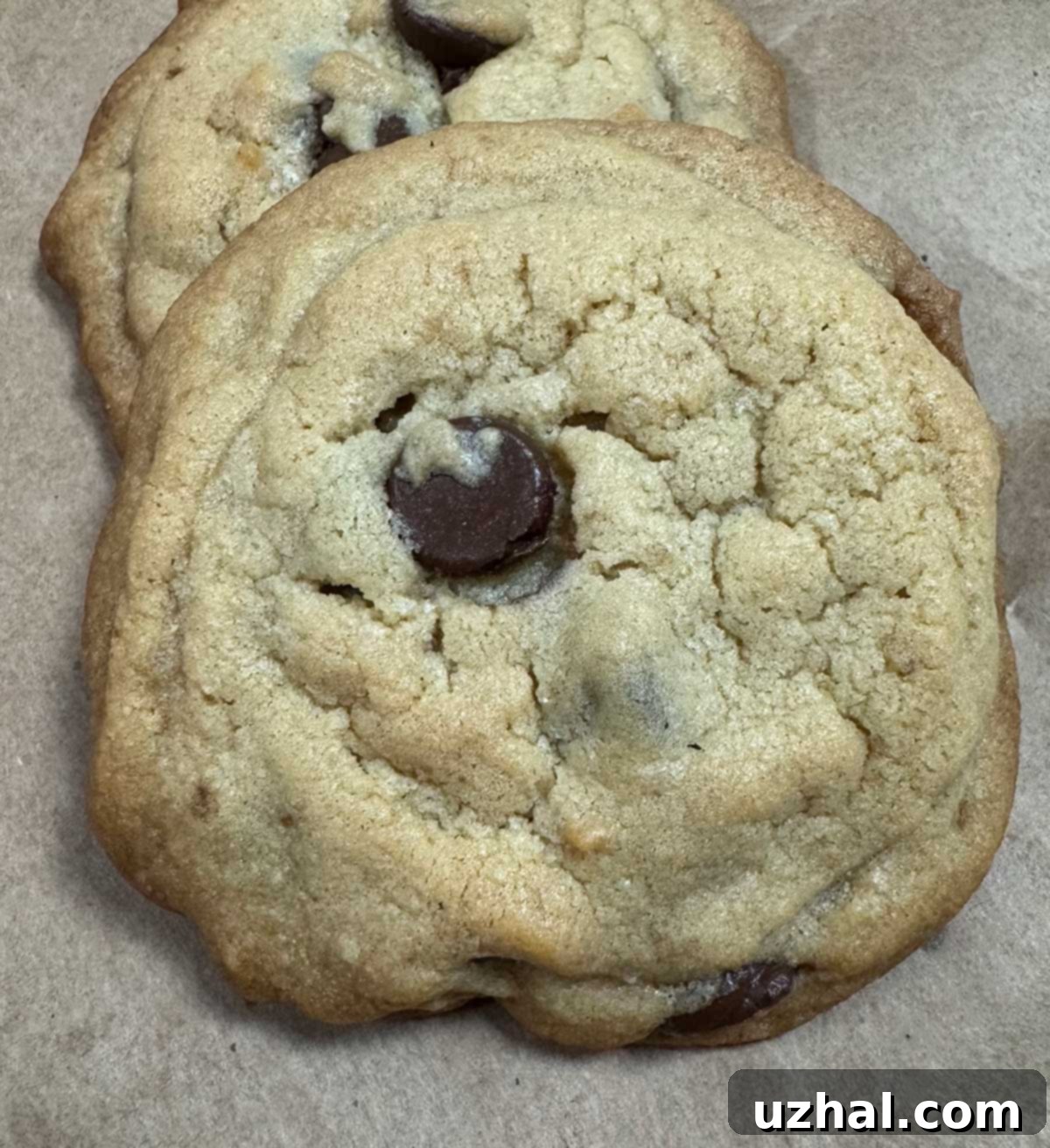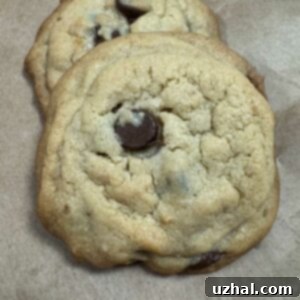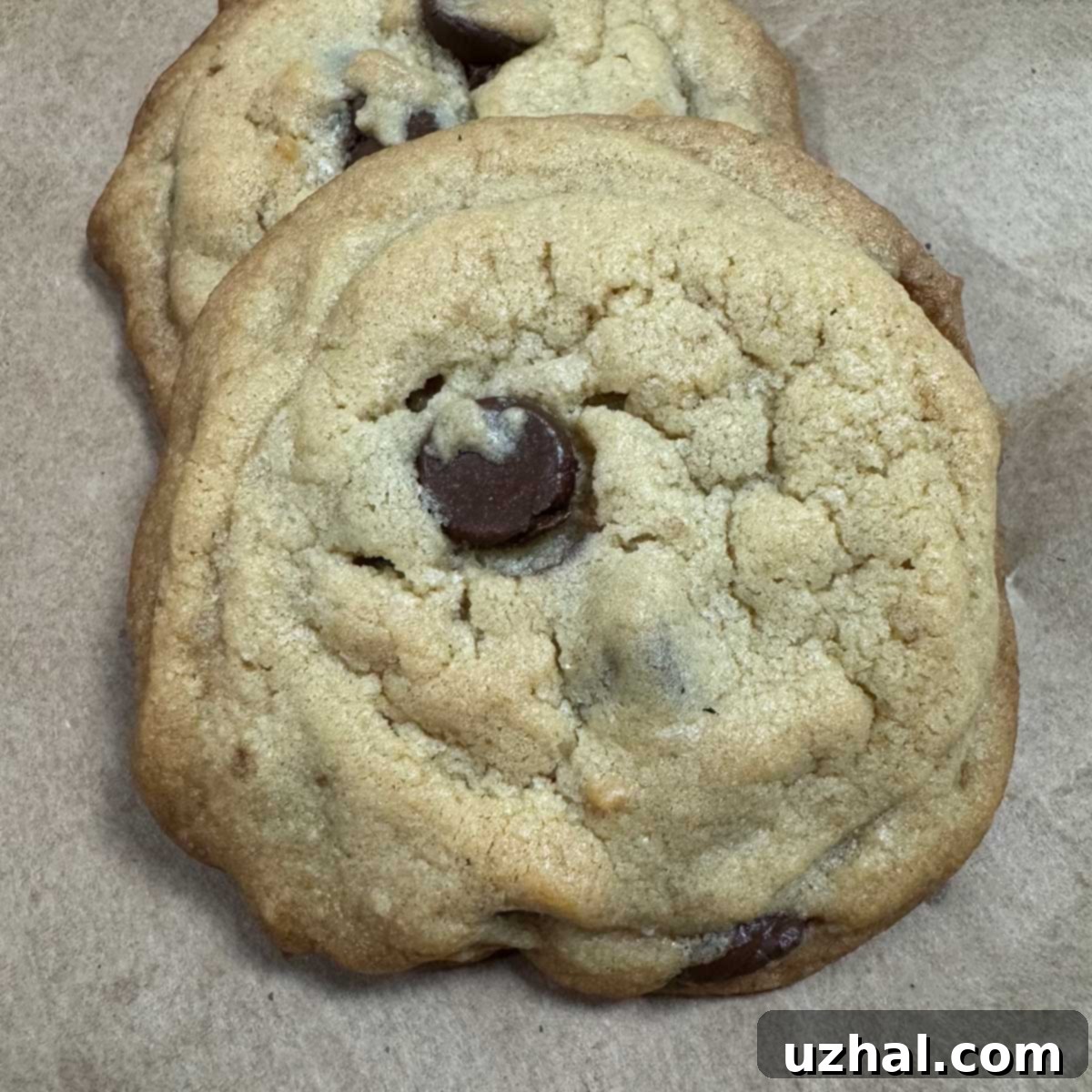Mastering Award-Winning Chocolate Chip Pudding Cookies: The Ultimate Recipe for Soft & Chewy Perfection
There’s a certain magic to a truly perfect chocolate chip cookie. It’s a delicate balance of crisp edges, a delightfully chewy center, and an explosion of melty chocolate goodness. Many years ago, my quest for this elusive perfection led me to an intriguing recipe: “Award Winning Chocolate Chip Pudding Cookies.” I first stumbled upon this gem on Clara Bakes, who, in turn, discovered it on Allrecipes.com. The original headnote on that recipe proudly shared a wonderful story: a member’s daughter, Tegan, had entered these very cookies into a contest and walked away with an award. This tale of triumph immediately captivated my imagination and fueled my desire to recreate such a celebrated treat in my own kitchen.

What makes a pudding cookie special? The addition of instant pudding mix is the secret ingredient that transforms an ordinary cookie into an extraordinary one. It’s renowned for imparting an incredible softness, enhancing the chewiness, and even extending the shelf life of your baked goods. For any home baker looking to elevate their chocolate chip cookie game, incorporating pudding mix is a game-changer. But like any truly great recipe, it required a bit of tweaking to suit my personal preferences and achieve what I consider the pinnacle of cookie perfection.
The Journey to My Perfect Pudding Cookies
Initial Impressions and the “Cakey” Challenge
The very first time I baked these chocolate chip pudding cookies, following the recipe as closely as possible, I was met with a good cookie, but not quite the *award-winning* texture I had envisioned. While undeniably delicious, they were a little too cakey for my taste. They were incredibly soft, almost like tiny cake rounds, and didn’t achieve the golden-brown crispness around the edges that I typically crave in a chocolate chip cookie. This initial batch was a stepping stone, a promise of potential, but it left me with a clear goal: to make them less cakey and more traditionally chewy.
Experimentation: Halving the Recipe and Fine-Tuning
Undeterred by my first attempt, I was determined to crack the code. For my second round of baking, I decided to cut the recipe in half. This not only allowed for smaller, more manageable batches for experimentation but also addressed a practical aspect: what to do with a half-used box of instant pudding mix? I often found myself with half a box leftover from other delightful recipes, such as my Small Batch Eclair Cake, making this adaptation incredibly convenient. So, I baked them again, using precisely half a standard 4-serving box of vanilla pudding mix. The verdict? Still a touch on the cakey side for me, but to my surprise, everyone else who tasted them absolutely raved! Their enthusiasm was infectious, making me realize that while my personal preference leaned towards a chewier cookie, the core recipe was undeniably a crowd-pleaser. The key now was to find that sweet spot that satisfied both my texture preference and everyone else’s adoration.
This led to years of subtle adjustments and continuous baking. I explored various techniques to reduce the cakey texture, focusing primarily on the egg content. Sometimes, I’d opt for a slightly smaller egg. Other times, I’d beat a standard large egg and simply discard a small portion, aiming for a more precise quantity. Each batch was a learning experience, bringing me closer to the ideal balance of softness and chewiness without veering into cake-like territory.
The Breakthrough: Unlocking Chewy Perfection
Through countless batches and dedicated experimentation, I finally arrived at a version of these pudding cookies that I consider truly perfect. The critical adjustments that transform these cookies from merely good to absolutely sublime focus on a few key elements:
- Very Soft Butter: This is paramount. Butter that is too cold will not cream properly and will create a denser, less airy dough. Butter that is perfectly soft, almost at the point of melting, incorporates more smoothly and contributes to a tender crumb.
- Minimal Creaming of Butter and Sugar: Unlike many cookie recipes that call for vigorous creaming to incorporate air, for these pudding cookies, I’ve found that less is more. Cream the butter and sugars just until they are blended and creamy, and no longer. Over-creaming introduces too much air, which can lead to a puffier, more cake-like texture.
- Precise Brown Sugar Measurement: Brown sugar is key to chewiness and moisture. I meticulously pack the brown sugar into measuring spoons/cups and aim for a weight of at least 75 grams. The higher molasses content in brown sugar aids in creating that desired soft and chewy texture.
- Reducing the Egg Content: This was perhaps the most impactful adjustment. Too much egg contributes significantly to a cakey texture. My ideal is to use a medium-sized egg, or precisely measure about 45 to 48 grams of egg if using a larger one. This slight reduction helps create a denser, chewier cookie that still holds its shape beautifully.
These subtle modifications, developed over years of baking and tasting, have made all the difference. The resulting cookies are wonderfully soft, incredibly chewy, and have just the right amount of spread and a perfectly golden hue without being overly brown. They are truly award-winning in my book!
Why Instant Pudding Mix is Your Secret Weapon
If you’re new to baking with instant pudding mix, you might wonder what magic it brings to cookies. The answer lies in its composition. Pudding mixes contain cornstarch, sugar, flavorings, and often stabilizers. When added to cookie dough, the cornstarch plays a crucial role:
- Increased Moisture: Cornstarch absorbs moisture, which helps keep the cookies soft and moist long after they’ve cooled.
- Enhanced Chewiness: The interaction of cornstarch with other ingredients contributes to a desirable chewy texture.
- Extended Freshness: Cookies made with pudding mix tend to stay soft and fresh for a longer period, resisting drying out.
- Flavor Boost: Beyond texture, the pudding mix (especially vanilla) subtly enhances the overall flavor profile of the cookie, adding a rich, creamy undertone.
It’s a simple addition that yields surprisingly profound results, transforming a good cookie into a truly exceptional one.
Key Ingredients for Success
Understanding the role of each ingredient is fundamental to mastering this recipe.
Butter: The Foundation of Flavor and Texture
As mentioned, the butter’s consistency is crucial. Use unsalted butter, softened to room temperature, but not melted. It should yield slightly when pressed but still hold its shape. This ensures proper emulsion with the sugars and uniform distribution throughout the dough.
Sugars: More Than Just Sweetness
This recipe uses a combination of brown sugar and granulated sugar. Brown sugar, with its molasses content, adds moisture and contributes significantly to the chewy texture. Granulated sugar aids in spread and a crispier edge. The ratio here is optimized for that perfect balance.
The Egg: A Delicate Balance
The egg acts as a binder, adds moisture, and helps with leavening. However, its quantity is critical for pudding cookies. A medium egg (approximately 45-48 grams) provides just enough binding without leading to an overly cakey texture.
Flour & Leavening: Structure and Lift
All-purpose flour provides the structure for the cookies. Measure it correctly, preferably by weight (140 grams), to avoid adding too much, which can result in dry, dense cookies. Baking soda is the leavening agent, giving the cookies a slight lift and contributing to their tender crumb.
Pudding Mix: The Game Changer
A half-box of instant vanilla pudding mix (about 48 grams) is the magic touch. While vanilla is a classic choice, don’t hesitate to experiment with other flavors once you’ve mastered the basic recipe!
Chocolate Chips: The Essential Indulgence
Semisweet chocolate chips are the standard for a reason, offering a perfect balance of sweetness and rich chocolate flavor. Feel free to use your favorite variety – milk chocolate, dark chocolate, or even a mix!
Mastering the Baking Process
Mixing for Perfection
Proper mixing is key to achieving the desired texture. Start by whisking your dry ingredients (flour, baking soda, salt) separately. This ensures they are evenly distributed. For the wet ingredients, cream the very soft butter and both sugars just until combined and creamy – avoid over-creaming. Then, beat in the instant pudding mix until well incorporated. Finally, add the vanilla extract and the carefully measured egg, mixing until just blended. When combining wet and dry ingredients, mix only until the flour is almost fully incorporated before adding the chocolate chips. Continue mixing until the flour streaks disappear. Overmixing develops the gluten in the flour, which can lead to tough cookies.
Chilling the Dough: A Crucial Step (Optional but Recommended)
While the recipe notes you can bake immediately, chilling the cookie dough for at least 30 minutes, or even overnight, can significantly improve the final product. Chilling allows the butter to re-solidify, which prevents the cookies from spreading too much in the oven. It also allows the flavors to meld and the flour to fully hydrate, resulting in a richer, more uniform texture.
Baking Temperatures and Visual Cues
Preheat your oven to 375 degrees F. Using a medium-sized scoop, portion the dough into mounds. Bake for 12 to 14 minutes. Look for slight browning around the edges and small cracks on the surface. These are your cues that the cookies are done. The beauty of pudding cookies is that they remain incredibly soft on the inside, even if the edges are a little crispier. If you prefer a paler cookie, you can try baking at a slightly lower temperature, around 350°F, and adjusting the time. For a browner, slightly crisper exterior while maintaining that soft interior, some bakers find success at 400°F for 10-12 minutes. The pudding mix ensures the insides stay moist and tender, regardless of your chosen baking temperature.
Customizing Your Pudding Cookies
Once you’ve mastered the base recipe, the possibilities for customization are endless!
- Pudding Flavor Variations: Don’t limit yourself to vanilla! Try instant chocolate pudding mix for double chocolate cookies, butterscotch for a rich, caramel-like flavor, or even cheesecake pudding mix for a unique twist.
- Add-Ins Galore:
- Swap semisweet chips for milk chocolate, dark chocolate, white chocolate, or a combination.
- Add chopped nuts like walnuts or pecans for extra crunch.
- Stir in dried cranberries, raisins, or chopped dried apricots for a fruity note.
- Sprinkles can add a fun, festive touch, especially for celebrations.
- A sprinkle of sea salt on top before baking enhances the chocolate flavor beautifully.
Storage and Enjoyment
These chocolate chip pudding cookies are best enjoyed fresh, but they also store remarkably well thanks to the pudding mix. Store them in an airtight container at room temperature for up to 3-5 days. For longer storage, you can freeze the baked cookies for up to 2-3 months. Thaw them at room temperature or warm them slightly in the microwave for that fresh-from-the-oven experience. The dough can also be frozen, scooped into balls, and stored in a freezer-safe bag for future baking sessions – simply add a few extra minutes to the baking time.
I hope this perfected recipe brings as much joy to your kitchen as it has to mine. It’s a testament to how a few thoughtful adjustments can transform a great recipe into a truly legendary one. Happy baking!
- Ghirardelli Impressions Easter Brownies
- Fudgy, Chewy, Cakey Brownies
- Soft Chocolate Chip Cookies
- Cakey Sweet Potato Bars
- Coconut Pudding Cookies
Recipe

Chocolate Chip Cookies with Pudding Mix
Anna
Pin Recipe
Ingredients
- 1 cup all-purpose plus a tablespoon (140 grams)
- ½ teaspoon baking soda
- ¼ teaspoon salt
- 8 tablespoons butter,very softened (114 grams)
- 6 tablespoons brown sugar, packed (75-80 grams)
- 2 tablespoons granulated sugar (25 grams)
- ½ box of the 4 serving size instant vanilla pudding mix (about 48 grams)
- 1 medium egg (approx. 45-48 grams)
- ½ teaspoon vanilla extract
- 1 cup semisweet chocolate chips
Instructions
-
Preheat oven to 375 degrees F (190°C).
-
In a medium bowl, whisk together the flour, baking soda, and salt. Set aside.
-
In a large bowl, using an electric mixer (or by hand if your butter is very soft), cream the very softened butter and both brown and granulated sugars just until blended and creamy. Do not over-cream. Beat in the instant pudding mix until fully incorporated. Once well mixed, add the vanilla extract and the medium egg (or 45-48g of egg) and stir until just blended.
-
Gradually add the flour mixture to the wet batter, stirring on low speed until it is almost fully mixed, with only a few streaks of flour remaining. Add the chocolate chips and continue stirring until the flour completely disappears and the chips are evenly distributed. Be careful not to overmix.
-
Using a medium-sized cookie scoop (about 1.5-2 tablespoons), shape the dough into mounds. You should get approximately 16 cookies. For best results and to prevent excessive spreading, cover the mounds on a dinner plate and chill them for at least 30 minutes, or up to 24 hours. Alternatively, you can bake immediately.
-
Place chilled cookie dough mounds on a baking sheet lined with parchment paper. Bake at 375 degrees F (190°C) for 12 to 14 minutes, or until the cookies appear slightly browned around the edges and small cracks have formed on the surface. For paler cookies, you can bake at a lower temperature (e.g., 350°F / 175°C) for slightly longer. For browner, slightly crisper cookies, some prefer baking at 400°F (200°C) for 10-12 minutes. The pudding mix ensures the interiors remain wonderfully soft regardless of the crust’s color. Let cool on the baking sheet for a few minutes before transferring to a wire rack to cool completely.
